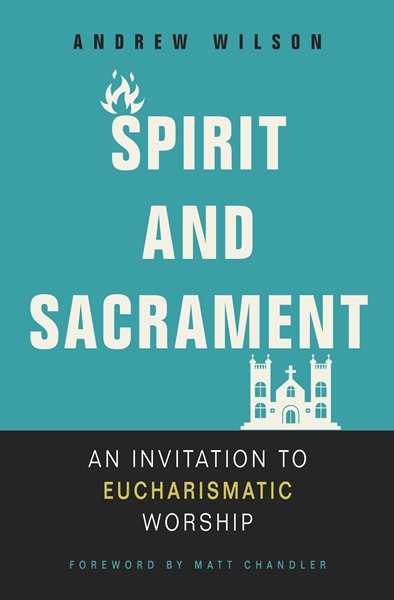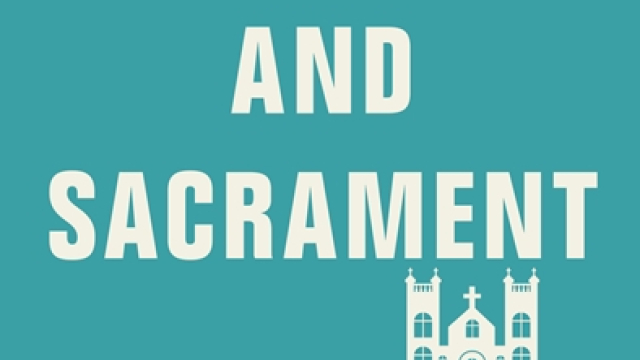Click to join the conversation with over 500,000 Pentecostal believers and scholars
Click to get our FREE MOBILE APP and stay connected
| PentecostalTheology.com



 Andrew Wilson, Spirit and Sacrament: An Invitation to Eucharismatic Worship (Grand Rapids, MI: Zondervan, 2018), 140 pages, ISBN 9780310534675.
Andrew Wilson, Spirit and Sacrament: An Invitation to Eucharismatic Worship (Grand Rapids, MI: Zondervan, 2018), 140 pages, ISBN 9780310534675.
Andrew Wilson has written a highly readable, engaging volume seeking the integration of the streams that are regularly treated as contrastive: sacrament and Spirit. It is not that these are actually contrastive, but too many folks imagine they are distinct. Those who worship with candles, lectionaries, church calendars, and vestments versus those who worship with shouts, dancing, speaking in tongues, and altar calls. Yet Wilson contends these are not contradictory and nor should they be. While he is not proposing an explicit apologetic for these two streams to be joined, he is offering an implicit one. Even more so he is speaking to those who already may think these should be found together and offering them support toward a more biblical reflection of integration as basic to the church. The movements of this book are simple (though not simplistic): (ch. 1) Spirit and sacrament, (chs. 2-3) charis “gift” and chara “joy”, (chs. 4-5) eucharistic and charismatic. The intent is a proposed (ch. 6) “eucharismatic” (eucharistic/sacramental and Spirit-ed/charismatic) expression and experience for the life of the local church. This new term (eucharismatic) is intended to bring the two expressions into a fruitful intertwining as expressive of the fuller life of the church.
One of the many values of this volume is its positive framing of church expressions that are often put into juxtaposition as if antithetical. A similar sort of distinction was noted fifteen years ago in Sam Storm’s testimony and articulation Convergence: Spiritual Journeys of a Charismatic Calvinist (Enjoying God Ministries, 2005) that juxtaposed “Calvinist” and “Charismatic” as poles that deserve to be brought together. Wilson’s own vision is less narrow by opening up to those which are sacramental/historic/liturgical and those which are charismatic/Pentecostal/renewal (with none of these terms intended as intentionally limiting to what might be offered). Wilson contends that the church that is committed to embodied life expresses itself in dress, smells, sounds, tastes, and movements that consider the whole person as incorporated into the life of the worshiping community. The integration of all of these as gifts and joy makes of a meaningful contribution to reflecting on the life of the church as it seeks faithful expression in local (and global) contexts.
Wilson contends that the church that is committed to embodied life expresses itself in dress, smells, sounds, tastes, and movements that consider the whole person as incorporated into the life of the worshiping community. The integration of all of these as gifts and joy makes of a meaningful contribution to reflecting on the life of the church as it seeks faithful expression in local contexts.
Another significant contribution is Wilson’s emphasis upon the confessional theological foundation of the life of God flowing in joy and abounding in gifts in and among God’s many people. At root is God’s self-revelation experienced and expressed in the life of the Spirit-ed community of Jesus’ body. Early in this volume, he makes the bold (but beautiful) claim that “all Christian theology is charismatic” (25) by noting that all we have is given as gift from God since “Christian theology is a theology of gift” (31, original emphasis). The life of God is shared within the Christian community through the expressions of every gift of God. This is expressed in joy (per Wilson’s further claim) overflowing. Not untouched by sorrows, but with accent clearly upon joy (44-45). Further, Wilson points to wine as gift which serves for joy and thankfulness of abounding celebration in life given by God. This is “eucharist” (thanksgiving) in celebration within the ongoing life of the church which is given this sacrament to celebrate regularly.
Wilson does not dictate what the eucharismatic life and church looks like as this is a work of the Spirit in the context of specific congregations seeking to live faithfully in their contexts. However, he reminds his readers that just as “the church encompasses the whole body of Christ—cerebral and emotion, high and low context, introvert and extrovert, spontaneous and controlled, Asian, African, American, European, and so on—then local churches need to worship in ways that help everyone find joy in God, through Christ, by the Spirit” (57, original emphasis). This is enabled both by the many tongues of Pentecost and the many prayers and liturgies of the church historic and global.
“[A]ll Christian theology is charismatic” –Andrew Wilson
If one is turning to this volume for some sort of sourcebook for resources about the integration of “sacrament and Spirit” then one will be sorely disappointed. This book does not seek to do that. Instead, he does offer some suggestions woven throughout, but only hinted at. For instance, reciting the Apostles Creed as congregational worship and creating specific space for messages of the prophetic and tongues with interpretation. It might be that this work could be helped by some sort of appendix (either for chapters or at the very end) which points to further resources for integration, questions to consider in specific ways of integration, some examples of ways various congregations and movements are handling such, etc. Understandably any specificity can take away from the living ways this book might provoke broader reflections and responses, but it could have aided some readers to consider specifics they had not previously considered.
The life of God is shared within the Christian community through the expressions of every gift of God. This is expressed in joy overflowing.
It should also be noted that this book is not an apologetic for the eucharismatic church even as it does offer theological support and justification for such. Instead, it functions more as encouragement to pastors and congregations that already find themselves somewhere on a journey within the broad spectrum of the two proposed streams of the church. In this way, this book provides language for a movement and encouragement toward reflective integration. Yet it should be born in mind that it might not be persuasive for those who are committed to one or the other expression without already being open to the other.
As a full-time pastor of 22 years and one who still serves pastors globally through teaching, mentoring, and discipleship I will be recommending this book to fellow pastors and those I disciple in the pastorate. This book would serve a local church or group of pastors seeking to reflect on these issues (whether they consider themselves more “eucharistic” or more “charismatic” or even already a bit of a blend). It has the great potential to offer language for carrying forward conversations and seeking further reflection on this field of study. This book is precisely the kind of entry level work on the subject to spur further readings and deeper reflections perhaps moving to engage other works which likewise seek to integrate such things at a more advanced and detailed level of reflection.
This may be precisely the time for transformation of congregations and ministers to take up Spirit and sacrament in earnest toward the fuller life of God in Christ.
Numerous books have begun appearing on this integrated approach including the many volumes by James K.A. Smith (not least in his three volume Cultural Liturgies series). Perhaps some of the following which have been written by classical Pentecostals might offer further reflections, such as Daniel Tomberlin’s Pentecostal Sacraments: Encountering God at the Altar (rev.; CreateSpace, 2015), Chris E. W. Green’s Toward a Pentecostal Theology of the Lord’s Supper: Foretasting the Kingdom (CPT Press, 2012), or Andrew Ray Williams’ Washed in the Spirit: Toward a Pentecostal Theology of Water Baptism (CPT Press, 2021). There are also works broadly Evangelical which promote the three streams of the evangelical, sacramental, and Pentecostal (with the “evangelical”) underlying all of Wilson’s work, but only implicit: e.g., Gordon Smith’s Evangelical, Sacramental, and Pentecostal: Why the Church Should be All Three (IVP Academic, 2017). Further, there are emerging movements globally which take their cue from early works such as Robert Webber’s Common Roots (first published in 1978) which intentionally sought to provoke the convergence of the evangelical, sacramental/liturgical, and charismatic/Pentecostal. This may be precisely the time for transformation of congregations and ministers to take up (and be taken up by) Spirit and sacrament in earnest toward the fuller life of God in Christ.
Reviewed by Rick Wadholm Jr
Publisher’s page: https://zondervanacademic.com/products/spirit-and-sacrament




Most Talked About Today